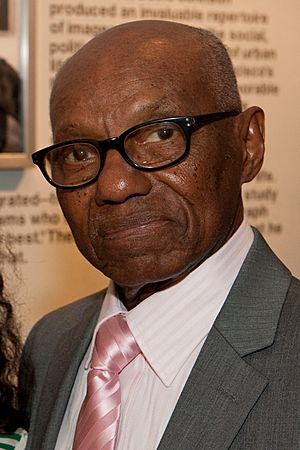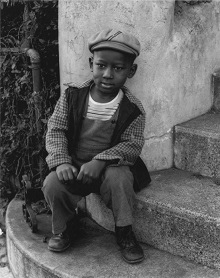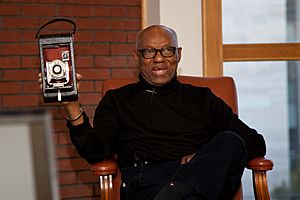David Johnson (photographer) facts for kids
Quick facts for kids
David Johnson
|
|
|---|---|

Johnson in 2010
|
|
| Born | August 3, 1926 Jacksonville, Florida, U.S.
|
| Died | March 1, 2024 (aged 97) |
| Known for | Photography |
David S. Johnson (born August 3, 1926 – died March 1, 2024) was an American photographer. He was famous for showing everyday life, city scenes, and the exciting jazz culture of San Francisco's Fillmore District in the 1940s and 1950s. He also photographed important people from the civil rights movement in the 1960s. Johnson grew up in Florida when laws kept Black and white people separate. He later studied at the California School of Fine Arts. He was the first African American student of the famous photographer Ansel Adams.
For many years, Johnson's work was not widely known. But in the early 2000s, his photos were shown in a film about the Fillmore District. Since then, his pictures have appeared in books and art shows. The Library of Congress even bought some of his work. His large collection of photos is now kept at the Bancroft Library at the University of California, Berkeley.
Contents
Early Life and Photography Dreams
David Johnson was born on August 3, 1926, in Jacksonville, Florida. He was raised by his foster parents, Alice and John Henry Johnson. He grew up in a poor, segregated part of Florida. David was the only one in his home who could read and write. He went to Lewis Grade School and Stanton High School in Jacksonville.
David became interested in photography as a child. He won a camera in a contest. His dream of becoming a photographer grew stronger during a summer trip to Washington D.C. when he was in high school.
Before finishing high school, David joined the U.S. Navy during World War II. He visited San Francisco while in the Navy. Then he was sent to the Philippines. After returning to Jacksonville, he read that Ansel Adams had started a special photography program. It was at the California School of Fine Arts.
Johnson had no formal photography training. But he had money from the G.I. Bill to help pay for school. He wrote to Adams, asking to join the program. He also told Adams that he was Black. Adams wrote back, saying race did not matter. He said the classes were full. But when a student left, Adams invited Johnson to join. He even offered Johnson a place to stay at his home until he found his own place.
San Francisco: The Golden Decade
Johnson arrived in San Francisco in 1945. For a short time, he lived at Adams' home in the Sea Cliff neighborhood. This made him Adams' first Black student. Johnson said Adams taught him to imagine a photo before taking it. He also said Adams photographing the Japanese internment camps made him interested in documentary photography.
Johnson became part of the "Golden Decade" (1945–1955) at the School of Fine Art. This was a group of photography students. They learned from famous artists like Adams, Imogen Cunningham, Dorothea Lange, and Minor White.
Capturing the Fillmore District
Johnson soon found the Fillmore District. This neighborhood was home to most of San Francisco's growing African American population. Johnson's photos are some of the only ones showing Black life in the Fillmore. This was before the area was rebuilt in the 1960s.
He photographed children, community members, and musicians. He also took pictures of important African Americans. These included Langston Hughes, Thurgood Marshall, Jackie Robinson, W. E. B. Du Bois, and Willie Brown. One of his favorite and most popular photos is of a 5-year-old boy. The boy is sitting on church steps. This photo, called Clarence, was the San Francisco Chronicle's Picture of the Week in 1947. It was also the first photo Johnson was paid for.
Life After Art School
Johnson graduated in 1949. He and his wife, Lucy, opened the Johnson Photography Studio. It was in San Francisco's Western Addition neighborhood. He also worked as a post office clerk. And he was a freelance photojournalist for local newspapers.
At the post office, he became active in the workers' union. In 1953, he became president of the San Francisco chapter of the National Alliance of Postal and Federal Employees. He had helped start this chapter. He also got involved in San Francisco politics and the local NAACP chapter. He was chosen to be a delegate to photograph the 1963 March on Washington. Eventually, he could not make enough money from his photography business. He closed his studio and stopped professional photography. He then focused on social and community work.
He became involved with the local Republican Party. He ran for San Francisco County sheriff in 1968 but did not win. Soon after, he was hired by the University of California, San Francisco (UCSF). He worked in the personnel department to hire more minority employees. He helped start the UCSF Black Caucus. In 1976, he received the Chancellor's Public Service Award. He retired from UCSF in 1983. At age 65, he went back to school. He earned a master's degree in social work from Barry University in Miami, Florida. He returned to the San Francisco Bay Area. There, he became a social worker for foster families.
Later Years and Legacy
In 1999, Johnson's daughter encouraged him to share his photos. This was for a KQED film about the history of the Fillmore District. The film used 17 of Johnson's old photos. This helped restart his photography career. In the summer of 2000, an exhibit of his Fillmore collection was held. It was at Fort Mason and the Center for African and African American Art and Culture. More exhibits of his old and new photos followed. These included shows at California State University, Chico, the University of California, Merced, and galleries in other cities.
In 2004, San Francisco Mayor Gavin Newsom gave Johnson a Certificate of Honor in Photography. In 2011, he received the Fillmore Heritage Pioneer Award. In 2012, he published a book called A Dream Begun So Long Ago. His wife, Jacqueline Annette Sue, wrote the book. He also served as chairman of the Mayor's Committee to Restore Haight Ashbury. He was also a past president of the San Francisco African American Historical & Cultural Society. His name is carved into the sidewalk of the Fillmore's Gene Suttle Plaza. In 2017, his name was considered to replace the name of San Francisco's Justin Herman Plaza.
Johnson saw himself as a modern-day "griot". A griot is a storyteller, historian, and narrator in West African culture. In his later years, he focused on preserving his legacy. He worked on a project about the Black slaves of Sullivan's Island, South Carolina. In 2016, the Bancroft Library at the University of California, Berkeley bought Johnson's archive. This collection includes about 5,000 negatives and prints. It was the first collection from an African American photographer to be kept at the library.
Personal Life
David Johnson had four children with his first wife, Lucy Ellis. Lucy passed away in 2008. He later married Jacqueline Annette Sue, who is an author. He lived in San Francisco's Fillmore District for a long time. Later, he moved to Marin County, where he lived in Greenbrae, California. David Johnson passed away on March 1, 2024, at the age of 97.



